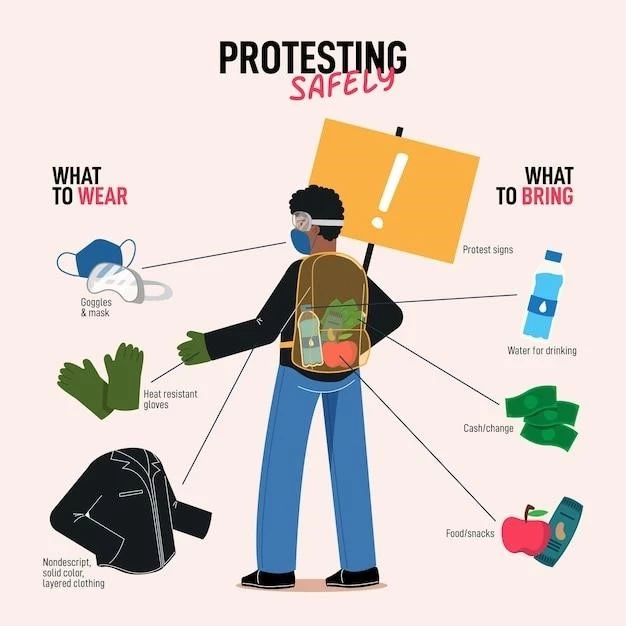Article Plan⁚ Permethrin ─ Uses and Safety
Permethrin is commonly used to treat scabies and lice infestations. It is also effective in repelling insects on clothing and gear, offering protection during outdoor activities like camping.
I. Permethrin Uses and Applications
Permethrin is a versatile synthetic chemical commonly used in various applications. It is primarily known for its effectiveness in treating scabies and lice infestations in humans. This topical medication works by paralyzing and killing the parasites, making it a go-to solution for infestation issues.
Aside from its medical applications, permethrin is also widely utilized as an insect repellent. It can be applied to clothing, tents, and other gear to protect against mosquitoes, ticks, and other bothersome bugs, making it an essential tool for outdoor enthusiasts, campers, hikers, and individuals in mosquito-prone areas.
Furthermore, permethrin plays a pivotal role in agriculture. It is commonly used as an insecticide to protect crops from pests, ensuring a higher yield and quality harvest. Its efficacy and versatility in pest control make it a popular choice among farmers and gardeners alike.
When using permethrin, it is crucial to follow the instructions provided by healthcare professionals or product labels carefully. This will help ensure its proper application and maximize its benefits while minimizing risks associated with misuse.
Overall, permethrin’s uses and applications span across various domains, ranging from medical treatment for parasitic infestations to agricultural pest control and personal insect repellent use. Understanding its versatility and following guidelines for safe usage can help harness the full potential of this compound in different settings.
II. Understanding Permethrin Side Effects
While permethrin is generally considered safe and effective when used correctly, it is essential to be aware of potential side effects that may occur. Common side effects include skin irritation, itching, redness, or a mild burning sensation at the application site. These side effects are usually mild and temporary.
In some cases, individuals may experience allergic reactions to permethrin, presenting as rash, hives, or swelling of the face, lips, or tongue. If you notice any severe allergic symptoms, seek medical attention immediately.
It is crucial to avoid applying permethrin to broken or irritated skin as it can increase the risk of side effects. Additionally, contact with eyes should be avoided, as it can cause irritation. If accidental contact occurs, rinse thoroughly with water.
In rare instances, more serious side effects such as dizziness, nausea, vomiting, or difficulty breathing may occur. These symptoms require immediate medical attention, and it is advisable to discontinue permethrin use if such reactions occur.
Consult with a healthcare provider if you have any concerns about potential side effects or if you experience unusual symptoms after using permethrin. Understanding and recognizing possible adverse reactions can help ensure safe usage and prompt management of any issues that may arise.
III. Permethrin Cream for Scabies Treatment
Permethrin cream is a commonly prescribed medication for the treatment of scabies, a contagious skin condition caused by the Sarcoptes scabiei mite. When using permethrin cream for scabies treatment, it is crucial to follow the prescribed regimen and application instructions carefully to ensure effectiveness.
Before applying the permethrin cream, it is essential to thoroughly clean and dry the affected areas of the skin. Gently massage the cream into the skin from the neck down to the soles of the feet, covering all areas including folds and creases. Avoid applying the cream to the eyes, nose, mouth, or genital areas.
Leave the permethrin cream on the skin for the recommended duration as specified by your healthcare provider, usually around 8-14 hours. After the allotted time, wash the cream off by taking a shower or bath. Be sure to launder all clothing, towels, and bedding used during the treatment period in hot water to prevent reinfestation.
It is important to complete the full course of permethrin treatment even if symptoms improve before the treatment is finished. This helps ensure complete eradication of the mites and reduces the risk of recurrent infestations.
If itching or skin irritation persists after treatment, consult with your healthcare provider for further guidance. Avoid using permethrin cream beyond the prescribed duration or in larger amounts than recommended, as it may lead to adverse effects.
Following proper application techniques and adhering to the treatment regimen will enhance the effectiveness of permethrin cream in treating scabies and help minimize the risk of reinfestation or complications associated with the condition.
IV. Managing Permethrin Toxicity and Overdose
While permethrin is generally safe when used as directed, it is essential to be cautious to avoid toxicity or overdose situations. In the event of accidental ingestion of permethrin, contact poison control or seek immediate medical attention.
Symptoms of permethrin toxicity may include dizziness, headache, nausea, vomiting, and in severe cases, seizures or loss of consciousness. If you suspect an overdose or experience any of these symptoms after permethrin exposure, do not hesitate to seek medical help.
When using permethrin products, always adhere to the recommended dosage and application instructions. Avoid applying excessive amounts of permethrin or using it more frequently than directed to prevent the risk of toxicity.
If applying permethrin to the skin, ensure that the treatment area is limited to the prescribed regions and avoid contact with mucous membranes, eyes, and open wounds. Wash hands thoroughly after applying permethrin to prevent unintended exposure.
Store permethrin products out of reach of children and pets in a secure location to prevent accidental ingestion. Dispose of expired or unused permethrin products properly according to local regulations.
If you suspect a pet has been exposed to permethrin-containing products, contact a veterinarian immediately, as permethrin toxicity can be harmful to animals; Be cautious when using permethrin around pets to prevent accidental exposure.
By following these safety guidelines and being mindful of potential risks associated with permethrin, you can effectively manage and reduce the likelihood of toxicity or overdose incidents, ensuring safe utilization of this compound for its intended purposes.
V. Permethrin Interactions with Other Drugs
Understanding potential interactions between permethrin and other medications or substances is crucial to ensure safe and effective treatment. While permethrin is primarily used topically, certain medications may interact with it, affecting its efficacy or increasing the risk of side effects.

Before using permethrin, inform your healthcare provider about any prescription or over-the-counter drugs, supplements, or herbal products you are currently taking. This includes mentioning any topical treatments or insect repellents to avoid potential interactions.
Some medications, such as corticosteroids or other topical treatments, may alter the absorption or effectiveness of permethrin. It is advised to wait a period of time between applying different topical products to prevent interference with each other’s actions.
Additionally, certain medical conditions or skin conditions may influence how your body reacts to permethrin. Conditions like eczema or damaged skin may increase the absorption of permethrin, potentially leading to adverse effects.
Alcohol consumption or tobacco use may also interact with permethrin, affecting its absorption or metabolism in the body. It is advisable to avoid alcohol-based products on the skin while using permethrin to prevent potential interactions.
If you experience any unexpected side effects or changes in your condition while using permethrin in conjunction with other drugs, contact your healthcare provider for guidance. They can provide insights on managing interactions or adjusting treatment plans to ensure optimal outcomes.
Being aware of potential interactions and seeking professional advice can help avoid complications and enhance the safety and effectiveness of permethrin treatment. By taking precautions and staying informed, you can navigate potential drug interactions and promote positive treatment outcomes.
VI. Safety Precautions when Using Permethrin Cream
When using permethrin cream, it is essential to prioritize safety to ensure effective treatment and minimize potential risks. Adhering to safety precautions can help promote positive outcomes and prevent adverse reactions.
Before applying permethrin cream, carefully read the instructions provided by your healthcare provider or on the product label. Follow the recommended dosage, application frequency, and duration of treatment to optimize results.
Ensure that the skin is clean and dry before applying permethrin cream. Avoid using harsh soaps or skin products that may irritate the skin, as this can increase the likelihood of side effects or unwanted reactions.
When applying permethrin cream, focus on covering the affected areas with a thin layer of the medication. Use gentle massaging motions to ensure even distribution and penetration into the skin, paying attention to folds and creases.
Avoid washing or wetting the treated skin immediately after applying permethrin cream. Let the cream remain on the skin for the recommended duration before washing it off. Consult your healthcare provider regarding the specific duration for your treatment.
Wash your hands thoroughly after applying permethrin cream to prevent unintentional contact with sensitive areas like the eyes, nose, or mouth. In case of accidental contact, rinse the affected area with water immediately.
During the treatment period, wash clothing, bedding, and towels in hot water to prevent reinfestation. Additionally, avoid close contact with individuals who may also be affected by scabies to prevent spreading the infestation.
If you experience persistent itching, redness, or irritation after using permethrin cream, consult with your healthcare provider for further evaluation and guidance. Do not exceed the prescribed dosage or duration of treatment without professional advice.
By following these safety precautions when using permethrin cream, you can effectively manage scabies infestations and promote healing while minimizing the risk of adverse effects. Prioritizing safety and proper application techniques is key to successful treatment outcomes.
